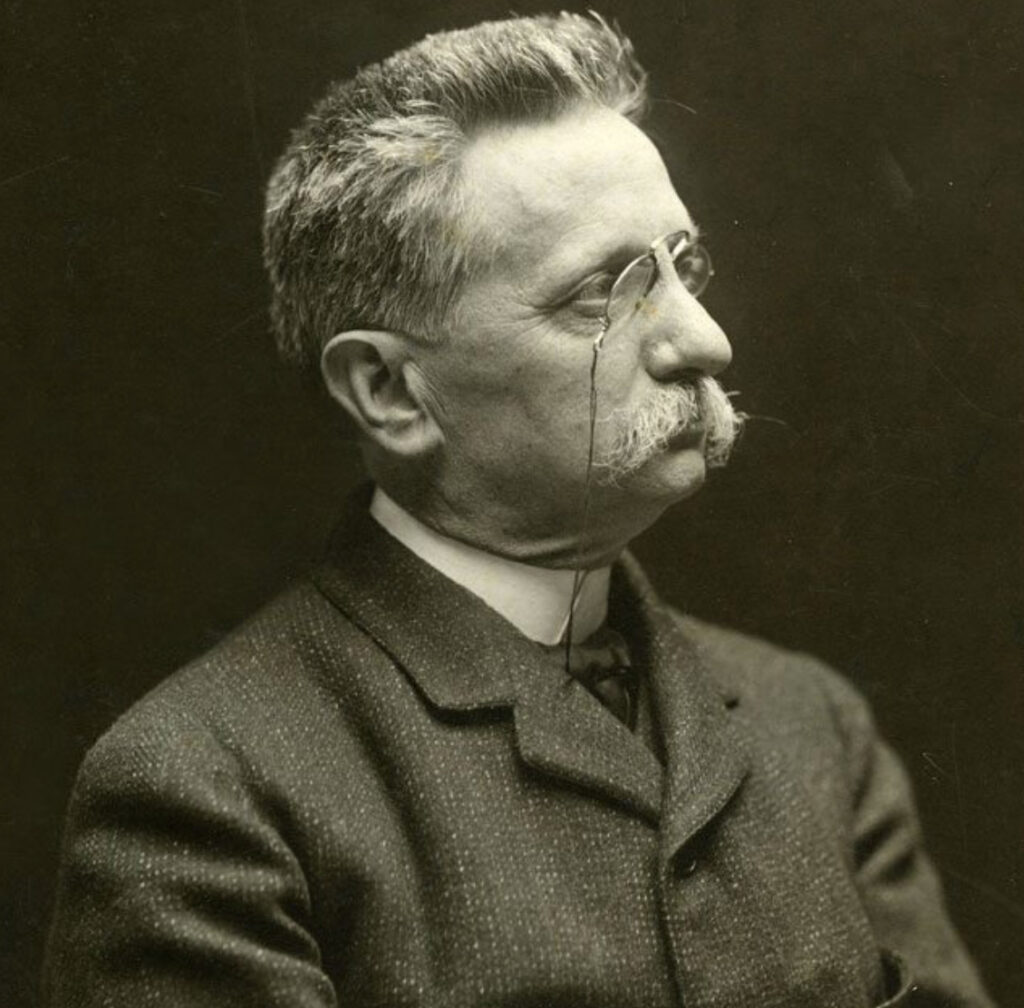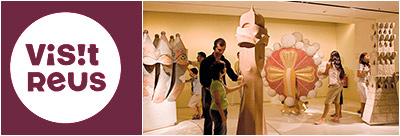Lluís Domènech i Montaner:
Master of masters
One of the most important architects of Catalan Modernism

Lluís Domènech i Montaner (Barcelona, 1849-1923) was one of the most important architects of Catalan Modernism. With a degree in architecture in 1873, he is the author of such imposing buildings as the Palau de la Música and the Hospital Sant Pau in Barcelona. As a young man he travelled around Europe, from where he imported technical knowledge and new materials that gave him a new vision of architecture.
This new technique coincided with the emergence of the new Catalan bourgeoisie, which immediately admired the work of the architect. It is not surprising, then, that he is one of the most prolific architects of the time and that some of his works have been recognised as World Heritage by UNESCO. As a teacher, he trained such outstanding disciples of Catalan modernism as Antoni Gaudí, Josep Puig i Cadafalch and Josep Maria Jujol.
The architect’s stylistic references, which can be seen in many of his buildings, are basically two: the Islamic world and Catalan Gothic. This mixture of styles is known as eclecticism and will be a trend throughout Domènech i Montaner’s career. On an aesthetic level, he materialised all this in his work En busca de una arquitectura nacional (In Search of a National Architecture) in 1871, in which he favoured eclecticism as a way of achieving a new, modern, and national architecture.
Montaner also excelled as a typeface designer, illustrator and bookbinder. Particularly important was his political side, committed to political Catalanism, he was the driving force behind the Regionalist League and a member of the Spanish parliament. He combined his profession with studies in heraldry and Romanesque art.
His life, stage by stage
The life of Lluís Domènech i Montaner (Barcelona, 1849 – 1923) was marked by a constant interest in many academic disciplines. Trained as an architect, he also played a significant role in the political life of his time. Professor, scholar of Catalan Romanesque and Gothic architecture, and expert in medieval heraldry are perhaps some of Domènech i Montaner’s least known facets.
Lluís Domènech i Montaner was born in Barcelona on December 21, 1850. Son of Pere Domènech i Saló, a publisher and prestigious bookbinder, and Maria Montaner Vila, from a wealthy family from Canet de Mar.
He graduated in Physical and Mathematical Sciences, then completed a Degree in Architecture, and later studied at the School of Architecture in the Real Academia de Bellas Artes de San Fernando de Madrid. Once he finished his studies, he travelled all over Europe to continue training and acknowledging the new architectural trends. It was then when he was impressed by the German traditional architecture.
As soon as the School of Architecture of Barcelona opened, he was hired as a professor along with José Vilaseca Casanovas, and worked as director of the educational centre until 1920. This position allowed him to establish the guidelines of Catalan modernism and to be the master of great architects of that time, such as Antoni Gaudí.
Also in 1875, he married María Roura Carnestoltes, daughter of a wealthy family of navigators from Canet de Mar, with whom he had eight children. The family lived in Barcelona but continued to vacation at Canet de Mart, their hometown.
In is the year in which the Universal Exhibition of Barcelona was held, an event that professionally consolidates Domènech i Montaner, as he received several commissions from Elies Rogent, director of the School of Architecture and the works of the exhibition. The Castle of the Three Dragons and the Hotel Internacional are some of his works from this period where he incorporated applied arts and ornamental solutions that will become common in his architecture. In that same year he joined the League of Catalonia, a political party of which he became president.
In this building, which served as a café and restaurant for the Universal Exhibition, we can clearly see one of the architect's greatest inspirations throughout his professional career: medieval art. This building is a reinterpretation of a medieval castle, in which the axis of symmetry is voluntarily broken, a tendency we will find in other buildings throughout Modernisme.
He founded Unió Catalanista and the following year he was appointed president of the political party together with Enric Prat de la Riba as secretary. In 1901 the party merged with the Regionalist Union and the Regionalist League was founded, formed mainly by the Catalan bourgeoisie that advocated for a free, strong and, autonomous Catalonia.
At the end of the 19th century, Reus lacked a therapeutic space for the mentally ill, as the existing one was totally outdated. For this reason, a few prominent people in the city got Domènech i Montaner to design the project for the psychiatric hospital. Built on the outskirts of the city so that patients could enjoy the fresh air, it was planned as a series of independent pavilions. It is considered the forerunner of the Hospital de Sant Pau in Barcelona.
The Pavelló dels Distingits (Pavilion of the Distinguished) stands out for its monumentality and was intended to house patients from the city's wealthy bourgeois families.
The first private house designed by the architect in the city of Reus. Owned by the notary Pere Rull Tria. The house was in private use until 1925, when the city council acquired it for use as a cultural facility.
Now known as Hotel Espanya, it was remodelled by Domènech i Montaner, together with other artists of his time. It is especially in the main dining room where we find this joint work between artists, as we have works by the sculptor Eusebi Arnau and the painter Ramon Casas, author of the magnificent sgraffito on the wall depicting a seabed with mermaids.
Also known as La guapa de la Mercadal (The beauty of the Mercadal), it is one of Domènech i Montaner's most personal works. Commissioned by the textile merchants Joaquim Navàs and Josepa Blasco, it is one of the most successful examples of Domenechian shop-house architecture.
Inside, the names of renowned artists of the Modernist period can be found: Alfons Juyol, Eusebi Arnau, Lluís Bru and Gaspar Homar, among others. In general terms, the decorative lines revolve around three main themes: nature, territory and political Catalanism.
This house completes the famous island of discord, together with Casa Batlló by Gaudí and Casa Amatller by Puig i Cadafalch. On the outside, the architect was clearly inspired by Gothic architecture.
On the ground floor, Domènech i Montaner designed a space for a shop, which unfortunately has not survived. Its decorations included sculptures representing classical muses, which were destroyed right in front of the house.
It is a period of architectural completeness for the architect. In 1905 the construction works for the new hospital complex began, and he continued and improved the avant-garde concepts applied to the psychiatric hospital Pere Mata. In 1911 the first part of the construction was inaugurated and from 1914 Domènech’s son was in charge of finishing the construction.
In 1905 the construction of the auditorium commissioned by the Orfeó Català began and was considered the greatest expression of Catalan modernism. The Palau de la Música, together with the Hospital Sant Pau, were awarded the Annual Concert of Artistic Buildings of the City Council of Barcelona in 1905 and 1913 respectively, and in 1997 the UNESCO catalogued them as a World Heritage Site.
A building in Reus that straddles the line between Modernism and Noucentisme. It was commissioned by the oil merchant Feliu Gasull. In this work, we can see how Domènech i Montaner's architectural language breaks with everything he had done up to that time.
In the last years of his life, Domènech i Montaner distanced himself from major architectural projects to focus on archaeological and historical research. Notably he wrote manusctripts on the history of Catalonia and Catalan heraldry at the Masia Rocosa in Canet de Mar, where he spent much of his final years, as he suffered from stomach cancer that led him to delegate all his professional work to his son, Pere Domènech Roura. He died in Barcelona at the age of 73 and was buried in the Sant Gervasi Cementry in Barcelona, although his final wish had been to be interred in the family pantheon in Canet de Mar.




